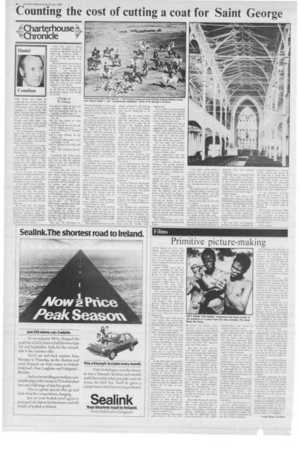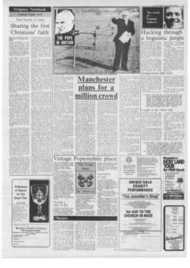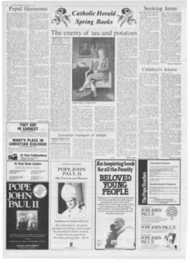Page 10, 23rd April 1982
Page 10

Report an error
Noticed an error on this page?If you've noticed an error in this article please click here to report it.
Tags
Share
Related articles
Splendid And Strange The Relics Of Long Ago
Conversion: A Supreme Sacrifice
The Crux Of Cross Purposes
Flowery Carpet In The Aisle For Corpus Christi
Profusion Of Priests For The Palace
10 C A T HO LIC HER ALD, n iig 3nAp 982 Oti the cost of cutting
a coat for Saint George THE MAN who might be called the true architect of the Charterhouse column, Patrick O'Donovan, once told me he thought it interesting that while the feast day of' Ireland's Patron, St Patrick, March 17, was known to everyone, English and Irish alike, few people nowadays took much notice of the day of England's Patron, St George.
This conversation took place a great many years ago: so he felt able to suggest that this might be because the English were to selfconfident to make a special fuss about national days.
However this may be. I wonder how, many people reading this have already remembered that St George's Day is to-day. April 23.
It could be — and as a man exactly half Irish and half English I say this with regret — that people are a bit vague about St George's Day, possibly because so much vagueness surrounds the Saint himself.
As we all know, the Vatican recorded its doubts about his very existence some years ago, although England's Catholics are permitted to honour him still.
A very old Perennial Calendar I have, which was published in 1824 by someone called T Foster, a man of wide and quaint interests, who seems to have been a Cambridge don. asserts the shadowy nature of the Saint at the very start of its entry for the feast day. Mr Foster says: "St George, styled the Champion of England, and his life. may be found in a legendary collection called The History of the Seven Champions of Christendome; a work formerly in great repute, though at present confined to the nursery."
After that, plainly fishing around for something to say, he records an odd belief among the Finns that "whoever makes a riot" on St George's Day "is in danger from storms and tempests".
More positively, he says that in Britain it was "an ancient custom" — he doesn't say how ancient — for "people of fashion" to wear blue coats on St George's Day: and he has one further bit of evidence, an actual document, that there was a time when we used to pay proper attention to our Patron.
This is an account taken from an old History of Reading for decorating a figure of St George on his day:
Charge of St George
First paid for three calf-skins and two horse skins. 4s 7d
Paid for making the loft that St
George standeth upon. 7d Paid for three planks for the same loft, 8d Paid for four pieces of clout leather, 2s 2d Paid for making the iron that the horse resteth upon, 6d Paid for making of St George's coat, 8d Paid to John Paynter for his labour, I4s Paid for roses, bells, girdle, sword and dagger, 3s 3d Paid for setting on the bells and roses, 3d Paid for nails necessary thereto. 10d Unscholarly Mr Foster gives no date to all this, but a learned lady tells me that the spelling, which I have not reproduced, suggests the early 17th or late 16th centuries.
Certainly they don't seem to have troubled about it much in that epoch. Take Shakespeare, for example, who must have encouraged many an aspirant young poet with the thought that he couldn't spell either, and, indeed, appears _never_to have written his name twice in the 'same way, providing a Mr Wise, of Philadelphia, with the idea for his book, published 1869 and surely never superseded, Autograph of William Shakespeare, together with 4,000 Ways of Spelling the Name.
That brings me back to the indefatigable Mr Foster, who notes that Shakespeare died on St George's Day, and that this had also been the day of his birth, April 23. 1564.
But. alas, The Dictionary of National Biography is not so sure about this. It thinks the birth date could have been April 22: so once again St George brings mists of uncertainty.
I am happy. however. to be able to draw attention to the fact that there has existed for 20 years a body dedicated to the purpose of exalting St George and his Day. This is the "Gild of St George", which by exercising, as it says, "quiet persuasion", through Parliamentarians and the Press, seeks to have St George's Day made a National Holiday.
The Gild — yes, it prefers that spelling — is also concerned with promoting poetry. art, music and crafts, centred on "a Catholic and National identity". according to its Secretary, Mr Anthony Cooney.
In this context, it is acting as the publisher of a new literary venture, a quarterly magazine of Catholic poetry, entitled Dowry. I have just seen the first number, which is modestly one of only 100 copies.
It is. in fact, modest in everything to do with its publication: for it consists of twelve pages of duplicated typescript on green paper-a -colour--which —lshall choose to believe symbolic of the fact that St George and St Patrick, being saints, have no quarrel with each other.
The Editor, Leonard Blackstone, seems to have cheerfully eclectic tastes in verse.
Although none of the pointers to this in the first issue of his magazine made me roll over on my back with all four paws in the air, the standard was high enough to suggest that future issues might contain treasures.
What pleased me most was the
subject selected for the drawing on Dowry's cover, a truly remarkable church dedicated to St George.
There are, of course, many splendid churches in England with this dedication, but none that I know of is quite like St George's, the Anglican parish church in Heyworth Street, Everton, of which Eric Williams made a line drawing for Dowry.
He shows the outside. What makes the church exceptional is best seen inside: for cast iron has been used for nearly all the decoration, with an effect that even the exacting eye of Sir Nikolaus Pevsner found "exceptionally delightful".
The window tracery, the arches, the roof ribbing, and the galleries with their columns are all of iron.
It was built between 1812 and 1814 to the design of Thomas Rickman, working in an historic collaboration with John Cragg, owner of the Mersey Iron Foundry, who has been called "a fanatic of cast iron for all purposes".
It seems Rickman had doubts at first, saying of Cragg: "His
-ironwork-is-too stiff in his head-to bend to any beauty." No doubt he changed his mind later.
I was once inside a Catholic church in which I thought someone had been trying in a small way to emulate Rickman and Cragg.
This seemed very astonishing indeed. because the church was in a distant and most exotic place. Peshawar, now in Pakistan, but once one of the last outposts of British India on the North-West Frontier. close to the Khyber Pass and the border with Afghanistan.
It was rather a moving building to be in, because it was originally a garrison church, put together with small means for Catholics in the British Army in India, so many of whom were Irish.
I was astonished to see that its roof seemed at first glance to be supported by vaguely Early English style columns of metal.
"Go closer, and you'll see what they really are," said the priest who was showing me round, "because you'll never guess He was right: the columns were in fact old railway lines, grouped and fastened in clusters which created a curiously Victorian Gothic effect.
Great improvisers were the British soldiery in those days, and good scroungers.
The Anglican church in Peshawar was equally startling, because its extreme Englishness, its positively Home Counties prettiness, came as a complete surprise in that place.
It was, as I remember it, chunky and cosy looking and shaded by tall trees. I believe there were roses about somewhere. Standing in that extra
nary frh riess, fThw yaT& from the highway that led to Kabul, I felt myself in a dream— even though I knew that British ways of life had impressed themselves deeply in this remoteness in Queen Victoria's day, and that squires from the shires, with the Colonel's Lady and Judy O'Grady, were already riding to hounds near Peshawar itself well before the end of the 19th Century.
The churchyard was very green, its tombstones stained with lichen. It was quite a while before I noticed that the greenness resulted from the fact that the whole area was irrigated by little channels of fresh water, and that an old, bearded man in a turban was clearing leaves out of one of them.
Hooked up at me, saluted in a positively military manner, and said, "Salaam, Sahib," alid that was the first time in real life that I ever heard this phrase.
But we were back in time with G A Henty.
Further to the North West I would soon be among the Pathan tribesmen, and they would, of course, be "hawk-faced", which, as a matter of fact, they were.
Kipling was with us, too. The tombstone in front of me had an Irish name on it which might have been that of his friend who was "a
sergeant once. but rejoiced afterward".
Beyond was a lych-gate that might have been in Surrey. Someone passed on its other side. It was not Joan Hunter Dunn carrying a tennis racket. It was a small, dark, _LurbanecL and cloaked man leading the first of a long string of cross and arrogant looking camels.
The fact that Henty and Kipling have somehow crept into Charterhouse, gives me a chance to return to Mr Anthony Cooney, Secretary of the Gild of St George, because he has written an article, in the current number of a little Catholic publication called Faith, on the subject of St George, Patriotism and Christian Virtue.
He says that for England. perhaps, no saint so expresses the
national aspirations to courage, civility, honour and martial art. He goes on to recall that St George is honoured throughout the Christian world; and that besides being the Champion Knight of Christendom in the West. hejs, in_the-East,-the Great— Martyr and the Trophy Bearer.
In the Orthodox churches especially he is invoked as the aider of the hopeless, says Mr Cooney, in his native Lebanon he is healer of lunacy, and in Greece he is patron saint of agriculture.
Mr Cooney concludes: "Who is so optimistic as to say that the curer of lunacy, the patron of good husbandry and the help of the hopeless has no relevance to England today?"
Who, indeed?
blog comments powered by Disqus











